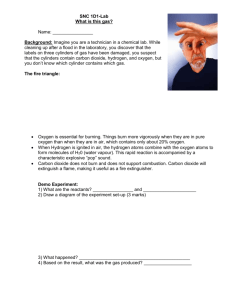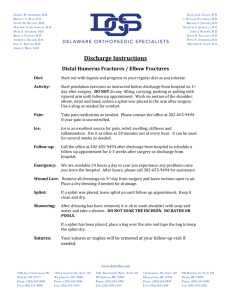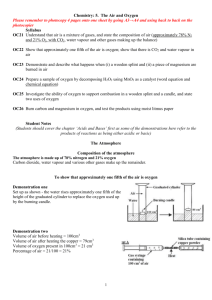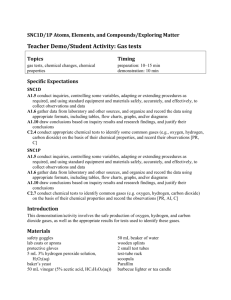DNL Tests caractéristiques des gaz Fiche professeur Matériel : Test
advertisement
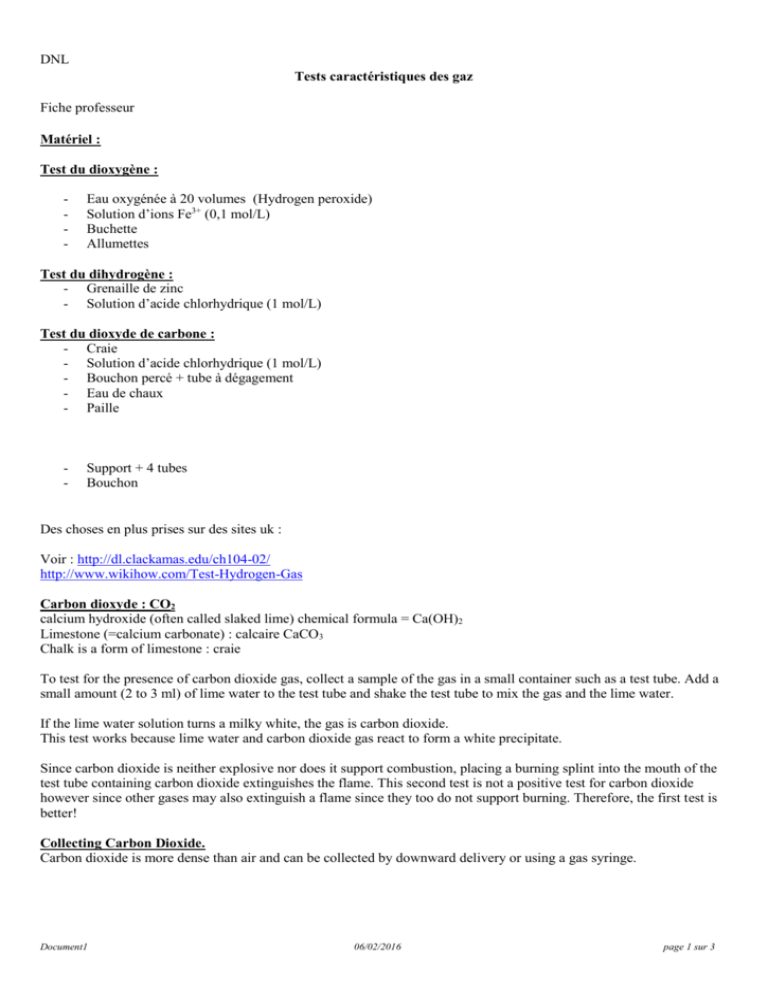
DNL Tests caractéristiques des gaz Fiche professeur Matériel : Test du dioxygène : - Eau oxygénée à 20 volumes (Hydrogen peroxide) Solution d’ions Fe3+ (0,1 mol/L) Buchette Allumettes Test du dihydrogène : - Grenaille de zinc - Solution d’acide chlorhydrique (1 mol/L) Test du dioxyde de carbone : - Craie - Solution d’acide chlorhydrique (1 mol/L) - Bouchon percé + tube à dégagement - Eau de chaux - Paille - Support + 4 tubes Bouchon Des choses en plus prises sur des sites uk : Voir : http://dl.clackamas.edu/ch104-02/ http://www.wikihow.com/Test-Hydrogen-Gas Carbon dioxyde : CO2 calcium hydroxide (often called slaked lime) chemical formula = Ca(OH)2 Limestone (=calcium carbonate) : calcaire CaCO3 Chalk is a form of limestone : craie To test for the presence of carbon dioxide gas, collect a sample of the gas in a small container such as a test tube. Add a small amount (2 to 3 ml) of lime water to the test tube and shake the test tube to mix the gas and the lime water. If the lime water solution turns a milky white, the gas is carbon dioxide. This test works because lime water and carbon dioxide gas react to form a white precipitate. Since carbon dioxide is neither explosive nor does it support combustion, placing a burning splint into the mouth of the test tube containing carbon dioxide extinguishes the flame. This second test is not a positive test for carbon dioxide however since other gases may also extinguish a flame since they too do not support burning. Therefore, the first test is better! Collecting Carbon Dioxide. Carbon dioxide is more dense than air and can be collected by downward delivery or using a gas syringe. Document1 06/02/2016 page 1 sur 3 Seconde, section euro, Practical course Gas tests You must speak to your partner in ENGLISH during all the course Lab vocabulary : To perform réaliser (une experience) To bind To sustain Glowing Wooden Splint Container Hydrogen peroxide Taste Slight Se lier Maintenir incandescent, rayonnant en bois buchette récipient Eau oxygénée Carbone dioxide Lime water Cloudy Milky Precipitate Limestone Chalk To put out To extinguish dioxyde de carbone eau de chaux trouble laiteux, blanchâtre précipité calcaire craie éteindre éteindre Le goût léger, minime To blow out To ignite éteindre Allumer, prendre feu Read the texts and perform the experiments when asked. I. Dioxygen molecule : O2 Introduction : Oxygen is a chemical element with symbol O and atomic number Z=8. At standard temperature and pressure, two atoms of the element bind to form dioxygen, a colorless, odorless, tasteless diatomic gas with the formula O2. This molecule is an important part of Earth's atmosphere (21%), and is necessary to sustain most terrestrial life. Inspired by Wikipedia The dioxygen molecule O2 is often called “oxygen” but it’s a mistake. Description of a dioxygen test (using a glowing splint) Light the end of a wooden splint and reduce the flame to the point that the end of the splint is simply glowing red but not burning. Insert the glowing end into the unknown gas's container and observe what happens. If the flame returns, the gas is dioxygen and is almost pure. Dioxygen relight the glowing splint. If the splint burns more brightly, there is dioxygen in the container. Inspired by : http://wiki.answers.com/Q/What_is_the_standard_test_for_oxygen Your experiment : Pour a few millimeters of hydrogen peroxide in a test tube. Add a bit of a solution containing Fe3+. Put a cork on the tube without closing it otherwise, it will jump because of the pressure. After a moment, you can perform a test to prove the released gas is dioxygen. II. Dihydrogen molecule : H2 Introduction : Hydrogen is a chemical element with symbol H and atomic number Z=1. At standard temperature and pressure, two atoms of hydrogen bind to form a diatomic gas (dihydrogen) with the molecular formula H2. It is a colorless, odorless, tasteless, non-toxic gas. Inspired by Wikipedia Description of a test (burning splint test) To test for the presence of dihydrogen gas, collect a sample of the gas in a small container such as a test tube. Light a wooden splint, but do not blow out the flame. Insert the burning splint into the mouth of the test tube. If the gas is dihydrogen, you will hear a slight explosive "pop" sound. This test works because dihydrogen will tend to mix slightly with the dioxygen in the air. Since this creates an explosive mixture, the burning splint will ignite the dihydrogen gas and you will hear a slight "pop" sound from the tiny explosion. Inspired by different websites Document1 06/02/2016 page 2 sur 3 Your experiment : Put a bit of solid zinc in a test tube. Add a few millimeters of hydrochloric acid (H+ + Cl-). Put a cork on the tube without closing it otherwise, it will jump because of the pressure. After a moment, you can remove the cork a few seconds and perform a test to prove the released gas is dihydrogen. III. Carbon dioxyde : CO2 Introduction : It is a gas at standard temperature and pressure and exists in Earth's atmosphere in this state, as a trace gas at a concentration of 0.039 per cent by volume. This gas has neither color nor smell. Description of a test Light a wooden splint and place the burning splint into the mouth of the test tube containing an unknown gas. If the flame is extinguished, the gas may be carbon dioxide but it’s not sure. Specific test (lime water test) : Bubble the gas through limewater. If carbon dioxide is present, the limewater will react with carbon dioxide and turn cloudy. A milky white precipitate of calcium carbonate will form. Lime water is a saturated solution of calcium hydroxide (often called slaked lime). Calcium carbonate is a white solid, and it is this that makes the lime water cloudy. calcium hydroxide contained in lime water + carbon dioxide → calcium carbonate + water. Ca(OH)2(aq) + CO2(g) → CaCO3(s) + H2O(l) Your experiment : - Put a bit of chalk in a test tube. Pour one millimeter of hydrochloric acid (H+ + Cl-). Perform two different tests to prove the released gas is carbon dioxyde. - Propose and perform a test to prove that there is carbon dioxide in the air your breathing out. At the end, write a conclusion for each of your test. You can make a quick drawing of the experiments. Document1 06/02/2016 page 3 sur 3
